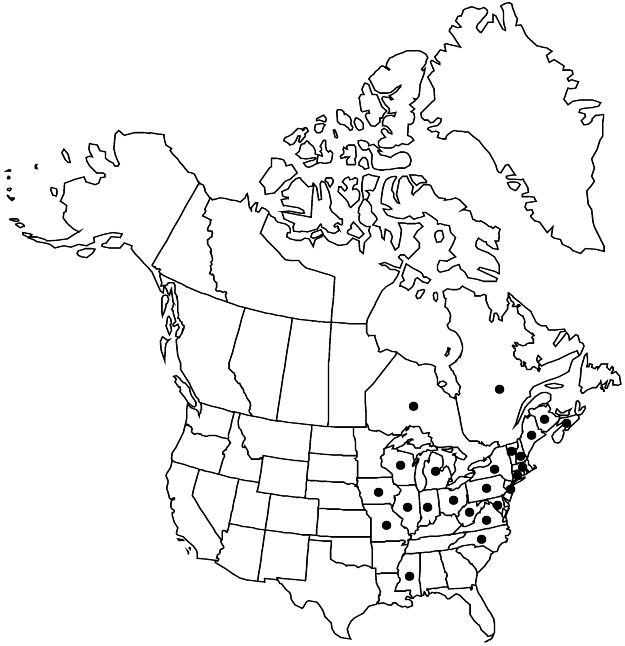Difference between revisions of "Filipendula rubra"
Rhodora 8: 204. 1906.
FNA>Volume Importer |
FNA>Volume Importer |
||
| Line 22: | Line 22: | ||
|name=Filipendula lobata | |name=Filipendula lobata | ||
|authority=(Gronovius ex Jacquin) Maximowicz | |authority=(Gronovius ex Jacquin) Maximowicz | ||
| − | }}{{Treatment/ID/Synonym | + | }} {{Treatment/ID/Synonym |
|name=Spiraea rubra | |name=Spiraea rubra | ||
|authority=(Hill) Britton | |authority=(Hill) Britton | ||
| − | }}{{Treatment/ID/Synonym | + | }} {{Treatment/ID/Synonym |
|name=Thecanisia angustifolia | |name=Thecanisia angustifolia | ||
|authority=Rafinesque | |authority=Rafinesque | ||
| − | }}{{Treatment/ID/Synonym | + | }} {{Treatment/ID/Synonym |
|name=T. lobata | |name=T. lobata | ||
|authority=(Gronovius ex Jacquin) Rafinesque | |authority=(Gronovius ex Jacquin) Rafinesque | ||
| − | }}{{Treatment/ID/Synonym | + | }} {{Treatment/ID/Synonym |
|name=T. purpurea | |name=T. purpurea | ||
|authority=Rafinesque | |authority=Rafinesque | ||
| Line 49: | Line 49: | ||
|elevation=0–1000 m | |elevation=0–1000 m | ||
|distribution=N.B.;N.S.;Ont.;Que.;Conn.;Ill.;Ind.;Iowa;Maine;Md.;Mass.;Mich.;Miss.;Mo.;N.H.;N.J.;N.Y.;N.C.;Ohio;Pa.;Vt.;Va.;W.Va.;Wis. | |distribution=N.B.;N.S.;Ont.;Que.;Conn.;Ill.;Ind.;Iowa;Maine;Md.;Mass.;Mich.;Miss.;Mo.;N.H.;N.J.;N.Y.;N.C.;Ohio;Pa.;Vt.;Va.;W.Va.;Wis. | ||
| − | |discussion=<p>Filipendula rubra is widely planted as an ornamental and is known only in cultivation or as an escape in the northern part of the listed range (eastern Canada, Maine, New York) as well as in West Virginia. The species is related to the east Asian F. angustiloba (Turczaninow) Maximowicz and F. palmata (Pallas) Maximowicz; it was used by Native Americans for heart troubles and love potions (D. E. Moerman 1998). The plant probably contains salicylic acid (natural precursor to aspirin), which has anti-inflammatory and analgesic effects. It has been used to treat gout, influenza, rheumatism, arthritis, fever, and kidney and bladder problems. The root is rich in tannins; it is used as an astringent in the treatment of, for example, diarrhea, dysentery, and bleeding (S. Foster and J. A. Duke 1990).</p> | + | |discussion=<p><i>Filipendula rubra</i> is widely planted as an ornamental and is known only in cultivation or as an escape in the northern part of the listed range (eastern Canada, Maine, New York) as well as in West Virginia. The species is related to the east Asian F. angustiloba (Turczaninow) Maximowicz and F. palmata (Pallas) Maximowicz; it was used by Native Americans for heart troubles and love potions (D. E. Moerman 1998). The plant probably contains salicylic acid (natural precursor to aspirin), which has anti-inflammatory and analgesic effects. It has been used to treat gout, influenza, rheumatism, arthritis, fever, and kidney and bladder problems. The root is rich in tannins; it is used as an astringent in the treatment of, for example, diarrhea, dysentery, and bleeding (S. Foster and J. A. Duke 1990).</p> |
|tables= | |tables= | ||
|references= | |references= | ||
| Line 73: | Line 73: | ||
|publication year=1906 | |publication year=1906 | ||
|special status=Endemic;Selected by author to be illustrated | |special status=Endemic;Selected by author to be illustrated | ||
| − | |source xml=https://jpend@bitbucket.org/aafc-mbb/fna-data-curation.git/src/ | + | |source xml=https://jpend@bitbucket.org/aafc-mbb/fna-data-curation.git/src/8f726806613d60c220dc4493de13607dd3150896/coarse_grained_fna_xml/V9/V9_31.xml |
|subfamily=Rosaceae subfam. Rosoideae | |subfamily=Rosaceae subfam. Rosoideae | ||
|tribe=Rosaceae tribe Ulmarieae | |tribe=Rosaceae tribe Ulmarieae | ||
Revision as of 19:16, 18 September 2019
Plants strongly rhizomatous, forming irregular patches, 12–25 dm. Rhizomes horizontal, thin, 2.5–3 mm wide, internodes 3–7 cm; root tubers absent. Stems glabrous. Leaves: basal 1 or 2, deciduous by flowering; stipules ovate to elliptic, 1–1.5 cm, base auriculate; lateral leaflets in 1–5 pairs, remote, ovate to elliptic, to 9 cm, palmately 2–3-lobed, lobes lanceolate, margins serrate or doubly serrate; terminal leaflets round, 10–15 cm diam., palmately 7–9-lobed, lobes oblanceolate to lanceolate, margins doubly serrate, apex acute to acuminate, surfaces hairy at least on veins, hairs appressed, straight, short, 0.5 mm, or adaxial glabrous. Inflorescences 100+-flowered; branches and pedicels glabrous. Flowers: hypanthium slightly concave; sepals (4–)5(–6), purplish, spatulate to triangular, 1–3 mm, margins without midrib, abaxially glabrous, adaxially finely appressed-hairy or glabrous; petals (4–)5(–6), pink to purple, orbiculate, 2.5–7 mm, claws distinct, short, base narrow, margins unevenly toothed; stamens pink to purplish, about equal to or longer than petals. Achenes 3–7, flattened, oblanceolate, straight, 8–14 mm, glabrous; stipes 0.5–1.5 mm; styles 1–2 mm.
Phenology: Flowering summer (Jun–Jul).
Habitat: Moist meadows and bogs, roadsides, ditches, often persistent in abandoned gardens
Elevation: 0–1000 m
Distribution

N.B., N.S., Ont., Que., Conn., Ill., Ind., Iowa, Maine, Md., Mass., Mich., Miss., Mo., N.H., N.J., N.Y., N.C., Ohio, Pa., Vt., Va., W.Va., Wis.
Discussion
Filipendula rubra is widely planted as an ornamental and is known only in cultivation or as an escape in the northern part of the listed range (eastern Canada, Maine, New York) as well as in West Virginia. The species is related to the east Asian F. angustiloba (Turczaninow) Maximowicz and F. palmata (Pallas) Maximowicz; it was used by Native Americans for heart troubles and love potions (D. E. Moerman 1998). The plant probably contains salicylic acid (natural precursor to aspirin), which has anti-inflammatory and analgesic effects. It has been used to treat gout, influenza, rheumatism, arthritis, fever, and kidney and bladder problems. The root is rich in tannins; it is used as an astringent in the treatment of, for example, diarrhea, dysentery, and bleeding (S. Foster and J. A. Duke 1990).
Selected References
None.
